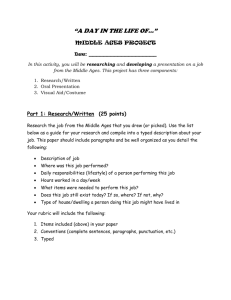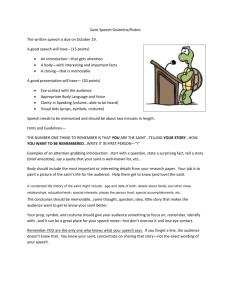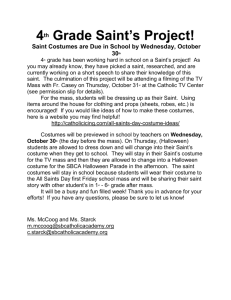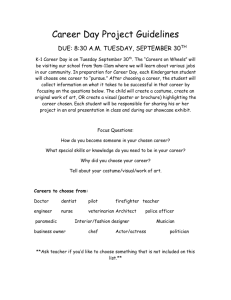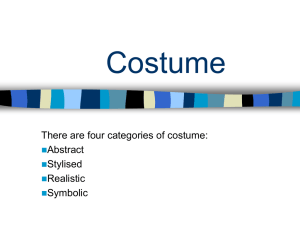How To Prepare Note Cards - confirmationcorner
advertisement
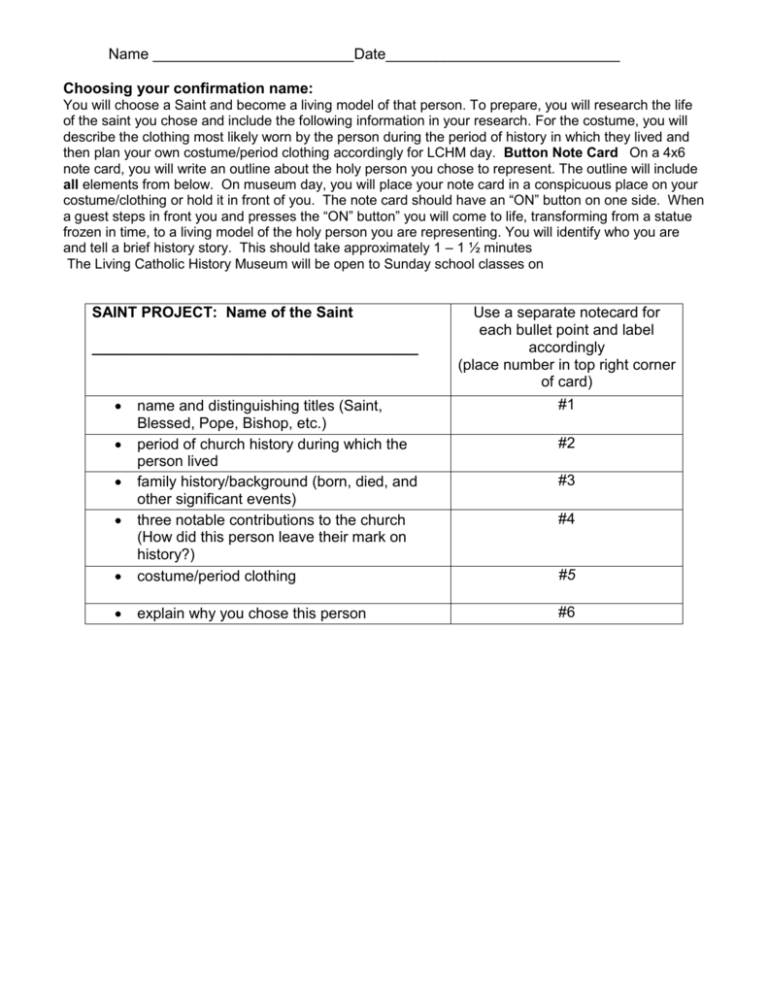
Name ________________________Date____________________________ Choosing your confirmation name: You will choose a Saint and become a living model of that person. To prepare, you will research the life of the saint you chose and include the following information in your research. For the costume, you will describe the clothing most likely worn by the person during the period of history in which they lived and then plan your own costume/period clothing accordingly for LCHM day. Button Note Card On a 4x6 note card, you will write an outline about the holy person you chose to represent. The outline will include all elements from below. On museum day, you will place your note card in a conspicuous place on your costume/clothing or hold it in front of you. The note card should have an “ON” button on one side. When a guest steps in front you and presses the “ON” button” you will come to life, transforming from a statue frozen in time, to a living model of the holy person you are representing. You will identify who you are and tell a brief history story. This should take approximately 1 – 1 ½ minutes The Living Catholic History Museum will be open to Sunday school classes on SAINT PROJECT: Name of the Saint _______________________________________ Use a separate notecard for each bullet point and label accordingly (place number in top right corner of card) #1 name and distinguishing titles (Saint, Blessed, Pope, Bishop, etc.) period of church history during which the person lived family history/background (born, died, and other significant events) three notable contributions to the church (How did this person leave their mark on history?) costume/period clothing explain why you chose this person #6 #2 #3 #4 #5 RESEARCH METHOD Required Information Use the rubric as your guide Evaluate Resources Destiny Quest 2 online resources 2 books January 15 Summarize Information Make note cards of your resources for the Works Cited page January 22 and 24 Note cards will be checked individually during class on January 28 Your note cards should show what is a direct quote, what is a paraphrase, and what you have summarized using your own words (original work) Minimum of 20 note cards Establish Organization Color code or group your cards using the rubric as a guide Arrange Information in Order Use the rubic as your guide Rough Draft and Revise Write the rough draft Read it out loud to catch any improper grammar or missing words Do peer edit Write the final research paper and Works Cited Page using MLA format Complete Project Hand in on Time Rough draft due January 28 Peer Edit due February 1 Final Research Paper due (at end of class) February 4 Religion Lesson Plans Thursday, January 10, 2013 1. Present examples of book source card and online source card in preparation for Saints Paper 2. Examine examples of plagiarism, paraphrasing and summarizing. 3. Review How to Prepare Note Cards and give examples of direct quotation note cards, paraphrase and summary notes. 4. Show students Works Cited page MLA format from presentation on Mrs. McKenna’s wikispace qaengligh@wikispaces.com 5. Create an example of (1) source note card, (2)direct quotation note card, (3) paraphrase and (4) summary (5) plagiarized note card. Monday, January 14, 2013 Spelling Bee during Religion Tuesday, January 15, 2013 1. Distribute baggies containing note cards (25 nc per bag. Min. of 20 nc for research paper) 2. Have students write their name on the baggie. 3. Distribute LCHM Assignment Sheet 1 of 2. Review rubric and research method checklist/timeline. 4. Students have four days (Tues.1/22, Thurs.1/24, Mon 1/28, Tues.1/29) to research, make note cards and work on their rough draft, works cited, and saint image (tagxedo). 5. Use teacher computer to show students how to access Destiny Quest 6. Students will begin research using Destiny Quest 7. Students will make source cards for their books and online resources and write note cards Thursday, January 17, 2013 Geography Bee during Religion Monday, January 21, 2012 No School Tuesday, January 22, 2013 1. Students will continue making note cards 2. Students will organize/color code note cards using the rubric as a guide 3. Students will arrange note cards in the order of the grading rubric 4. Teacher will check note cards as they are doing research and to make sure student has minimum number of note cards before they can begin typing. 5. Teacher will give individual student permission to begin their rough draft. 6. Students will continue to work on their rough draft and Works Cited page (MLA format). Thursday, January 24, 2013 1. Students work on note cards, the rough draft of their research paper and the Works Cited page (Citation Maker – MLA format). 2. Teacher will check note cards as they are doing research Monday, January 28, 2013 1. Students will print a copy of their rough draft before the end of class and turn it in to the teacher 2. Teacher collects rough drafts and writes notes to and comments to students 3. Teacher makes list of peer editors Tuesday, January 29, 2013 1. Another day to work on rough draft and works cited page Friday, February 1, 2013 1. Teacher assigns peer editors (1&2, 3&4, etc.) 2. Constructive comments only 3. Students will follow these instructions for peer edit 1. Technical Capitalization Appearance Punctuation Spelling 2. Content – Does the paper have all the elements in the rubric? 3. Basic writing skills- Does the paper flow? Is there an intro? A conclusion? 4. Student will give peer editor their assignment sheet so they can initial it 5. Students will create a word document SAVE AS Name of Saint with these elements: 1. Student Name 2. Saint/Holy Person Name 3. Peer Editor 4. Bullet list containing edits and comments 6. Peer Editor will print bullet list 7. Students will return to their seats and make changes as needed based on edits 8. Teacher will collect Peer Editor Notes Example of Book Source Card This will help you find the book later Call number Author’s name – Last name, First name Title of Book Place of publication: Publishing company, Copyright date Example of Online Source Title of article Author(s) Date of electronic publication Title of web page de Vera, Ed. “Mary as Ark of the Covenant.” Totus Tuus, Maria. 17 Dec. 2010. All About the Virgin Mary. 17 Dec. 2010. Date of download <http://www.all-about-the-virgin-mary.com/ark-of-the-covenant.html> Title of larger site URL How To Prepare Note Cards PROCEDURE 1. Always create a bibliography card for a source before you take notes. 2. Make sure note cards indicate what is quoted and what is paraphrased. 3. Before you leave the library, make sure you have written a page number in the lower left corner of each note card. 4. Be neat, and pay attention to formatting details. 5. Develop a system for keeping your note cards organized. CAUTIONARY NOTE ABOUT PLAGIARISM Avoid plagiarism; never use the words of another source as if they are your own. Take notes in phrases, not sentences. Use quotation marks for any information you copy directly from another source. When you paraphrase, remember to give credit whenever you retain the main thought and structure of another source, regardless of your changes. Not only does plagiarism violate the honor code, but it is also an offense punishable by law. To avoid plagiarism, make a clear distinction on your note cards between the material you quote directly (with quotation marks) and the material you paraphrase. EACH CARD SHOULD CONTAIN: 1. 2. 3. 4. 5. only one idea a specific topic label for that card the author of the work (if no author, use title) a note (one of the three types) the page number(s) WHAT TO NOTE 1. any information that supports the thesis o facts o statistics o definitions 2. statements by authorities on the subject TYPES OF NOTE CARDS: direct quotation note cards, paraphrase note cards, and summary note cards 12/9/2010 <http://www.profgreen.tv/Note.htm> DIRECT QUOTATION NOTE CARDS Use a DIRECT QUOTATION note when the author has phrased something particularly well, when the words express a meaning as no other words could, or when an authority has concisely stated an opinion relevant to your speech. STEPS TO FOLLOW 1. Copy the quotation exactly. 2. Check to make sure you have copied all spelling and punctuation exactly. 3. Make sure that the section of the work you quote does not need the surrounding material to keep the same meaning. SAMPLE DIRECT QUOTATION NOTE CARD 12/9/2010 <http://www.profgreen.tv/Note.htm> PARAPHRASE NOTE CARDS Use a PARAHRASE NOTE most of the time, putting another's ideas into your own words. STEPS TO FOLLOW 1. Ask yourself the author's purpose and/or main idea. 2. Put the idea into your own words. 3. Read what you have written to be sure that it reflects the author's idea. SAMPLE PARAPHRASE NOTE CARD 12/9/2010 <http://www.profgreen.tv/Note.htm> SUMMARY NOTE CARDS Use a SUMMARY NOTE to record in your own words the essence of a passage without examples and explanations. Summary notes are usually for less important or repetitive information. STEPS TO FOLLOW 1. Ask yourself the author's purpose and/or main idea. 2. Write that idea in a few words. SAMPLE SUMMARY NOTE CARD 12/9/2010 <http://www.profgreen.tv/Note.htm> 8th Grade Catholic Church History AD 33-present day Living Catholic History Museum Assignment Sheet Name___________________________ Date____________________________ Part 2 of 2: Button Note Card On a 4x6 note card, you will write an outline about the holy person you chose to represent. The outline will include all elements from the rubric. On museum day, you will place your note card in a conspicuous place on your costume/clothing or hold it in front of you. The note card should have an “ON” button on one side. When a guest steps in front you and presses the “ON” button” you will come to life, transforming from a statue frozen in time, to a living model of the holy person you are representing. You will identify who you are and tell a brief history story. This should take approximately 1 – 1 ½ minutes. Note card due date: Thursday, February 7, 2013 The Living Catholic History Museum will be open to the school public on Tuesday, February 12, 2013 and the holy people will be on display from 8:20-9:15. It will be best to wear your costume/period clothing over your school uniform. You will be given approximately seven minutes before the museum “opens” to put on your costume so keep within that time limit. GRADING RUBRIC Points Possible name and distinguishing titles (Saint, Blessed, Pope, Bishop, etc.) period of church history during which the person lived 5 family history/background (born, died, and other significant events) 20 most notable contribution to the church (How did this person leave their mark on history?) dressed in costume/period clothing 30 name and picture of saint on note card (side of “ON” button) 20 TOTAL 5 20 100 Peer Check (student’s initials) ______ Part 2 Points Earned TO DO Last week of October November February 4th February 7th February 5th Present overview of assignment to 8th graders Have students sign up for the holy person who they will represent Email invite to 3rd and 4th grade teachers Saints Project Paper for Living Catholic History Museum is due Do costume/period clothing check Do you have all the pieces for your costume? Period clothing tips you want to share with classmates? Is clothing appropriate? Costume and notecard due Make list/arrange saints by century Layout/map spacing – one arm’s length apart Make room in storage closet for costumes which will be stored from February 7th – February 16th Make arrangements for classes that will be affected since the museum extends beyond first period. ENGLISH/ART On 2/12: o Switch for Rel 7B will have Rel in Sci 8A will go to 7B o Costumes changes will take place as follows: 8A will go to the English Room after homeroom (KS to supervise) 8B will go to the Media Center after homeroom (MBS to supervise) At 9:10, 8A goes to 7B and 8B goes to Media Center to remove costumes and go to class. Send email reminder to 3rd and 4th grade teachers Send email to SPC requesting alternate entry to building so as not to disturb 8:30 Mass flow Send email reminder to NHerlihy and EMcKenna that students will be late for 2nd period – plan for 9:20 start time for 2nd period Explain process: Two rotations: 3rd grade = 8:25-8:45 4th grade = 8:50-9:10 Living Statues are arranged by century Students (museum guests) will enter the McNamee Hall. The statues will already be in place. Each guest will stand in front of one statue. A tambourine will sound, they press the button on the statue and they listen to the history story. The tambourine sounds the guest takes a step to the right and presses the button on the next statue. The process continues until time is called. Due to time constraints, the students will not be able to interact with all the statues but they will get a snippet of church history! February 7th February 11th February 12th 8A & 8B form a line and practice their talk in cafeteria Make this dress rehearsal day Time them getting dressed, getting to the church and getting in place. Also practice their history story. Museum Day Borrow tambourine or xylophone from Music Room All students in costume/period clothing (over their uniform) Exhibit opens at promptly at 8:20 Arrange living statues by century MixBook http://www.mixbook.com Tagexudo - http://www.tagxedo.com/ Create colorful, graphical 'word clouds' from text that you provide. Apply custom layouts, fonts and colors, Super cool.

